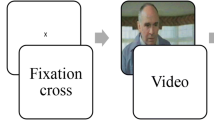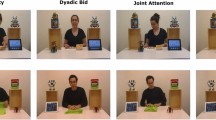Abstract
The adaptive threat-detection advantage takes the form of a preferential orienting of attention to threatening scenes. In this study, we compared attention to social scenes in 15 high-functioning individuals with autism (ASD) and matched typically developing (TD) individuals. Eye-tracking was recorded while participants were presented with pairs of scenes, either emotional positive-neutral, emotional negative-neutral or neutral–neutral scenes. Early allocation of attention, the first image fixated in each pair, differed between groups: contrary to TD individuals who showed the typical threat-detection advantage towards negative images, the ASD group failed to show a bias toward threat-related scenes. Later processing of stimuli, indicated by the total fixation to the images during the 3-s presentation, was found unaffected in the ASD group. These results support the hypothesis of an early atypical allocation of attention towards natural social scenes in ASD, that is compensated in later stages of visual processing.



Similar content being viewed by others
Notes
A pilot study was conducted to evaluate valence and arousal values of the pictures drawn from commercially available sources. Forty-seven students (Mage = 19.8; SD = 7.3) rated a total of forty pictures for valence (from 1, very pleasant, to 9, very unpleasant), and arousal (from 1 very stimulating, to 9, very unstimulating) using the Self-Assessment Manikin (Bradley and Lang 1994). Each image was presented in random order for 10 s, and participants were asked to make the valence and arousal ratings independently and to try to use the whole scale. According to the rating results, four emotionally positive (valence M = 7.0; SD = 0.3; arousal M = 6.1; SD = 0.3), and fourteen neutral pictures (valence M = 4.96; SD = 0.4; arousal M = 4.6; SD = 0.8) were selected.
References
American Psychiatric Association. (2000). Diagnostic and statistical manual of mental disorders (4th ed.). Washington, DC: APA.
Ashwin, C., Wheelwright, S., & Baron-Cohen, S. (2006). Finding a face in the crowd: Testing the anger superiority effect in Asperger Syndrome. Brain and Cognition, 61(1), 78–95.
Bannerman, R. L., Milders, M., de Gelder, B., & Sahraie, A. (2009). Orienting to threat: Faster localization of fearful facial expressions and body postures revealed by saccadic eye movements. Proceedings in Biological Sciences, 276(1662), 1635–1641.
Blanchette, I. (2006). Snakes, spiders, guns, and syringes: How specific are evolutionary constraints on the detection of threatening stimuli? Quarterly Journal of Experimental Psychology (Colchester), 59(8), 1484–1504.
Boyer, P., & Bergstrom, B. (2011). Threat detection in child development: An evolutionary perspective. Neuroscience and Biobehavioral Reviews, 35(4), 1034–1041.
Bradley, M. M., & Lang, P. J. (1994). Measuring emotion: The self-assessment manikin and the semantic differential. Journal of Behavioral Therapy and Experimental Psychiatry, 25, 49–59.
Calvo, M. G., Nummenmaa, L., & Hyönä, J. (2008). Emotional scenes in peripheral vision: selective orienting and gist processing, but not content identification. Emotion, 8(1), 68–80.
Chawarska, K., Volkmar, F., & Klin, A. (2010). Limited attentional bias for faces in toddlers with autism spectrum disorders. Archives of General Psychiatry, 67(2), 178–185.
Dawson, G., Carver, L., Meltzoff, A. N., Panagiotides, H., McPartland, J., & Webb, S. J. (2002). Neural correlates of face and object recognition in young children with autism spectrum disorder, developmental delay, and typical development. Child Development, 73(3), 700–717.
Dawson, G., Toth, K., Abbott, R., Osterling, J., Munson, J., Estes, A., et al. (2004). Early attention impairments in autism: social orienting, joint attention and attention to distress. Developmental Psychology, 40(2), 271–283.
Dichter, G. S., Benning, S. D., Holtzclaw, T. N., & Bodfish, J. W. (2010). Affective modulation of the startle eyeblink and postauricular reflexes in autism spectrum disorder. Journal of Autism and Developmental Disorders, 40, 858–869.
Eastwood, J. D., Smilek, D., & Merikle, P. M. (2001). Differential attentional guidance by unattended faces expressing positive and negative emotion. Perception & Psychophysics, 63, 1004–1013.
Esteves, F., Parra, C., Dimberg, U., & Öhman, A. (1994). Nonconscious associative learning: Pavlovian conditioning of skin conductance responses to masked fear-relevant facial stimuli. Psychophysiology, 31(4), 375–385.
Fletcher-Watson, S., Leekam, S. R., Benson, V., Frank, M. C., & Findlay, J. M. (2009). Eye movements reveal attention to social information in autism spectrum disorder. Neuropsychologia, 47, 248–257.
Fox, E., Lester, V., Russo, R., Bowles, R. J., Pichler, A., & Dutton, K. (2000). Facial expressions of emotion: Are angry faces detected more efficiently? Cognition and Emotion, 14, 61–92.
Freeth, M., Chapman, P., Ropar, D., & Mitchell, P. (2010). Do gaze cues in complex scenes capture and direct the attention of high-functioning adolescents with ASD? Evidence from eye-tracking. Journal of Autism and Developmental Disorders, 40(5), 534–547.
GazeTracker Software Guide, v8. (2008). Eye Response Technologies Inc.
Gerritsen, C., Frischen, A., Blake, A., Smilek, D., & Eastwood, J. D. (2008). Visual search is not blind to emotion. Perception & Psychophysics, 70, 1047–1059.
Hahn, S., Carlson, C., Singer, S., & Gronlund, S. D. (2006). Aging and visual search: Automatic and controlled attentional bias to threat faces. Acta Psychologica (Amst), 123(3), 312–336.
Horstmann, G., & Bauland, A. (2006). Search asymmetries with real faces: Testing the anger-superiority effect. Emotion, 6, 193–207.
Jones, W., Carr, K., & Klin, A. (2008). Absence of preferential looking to the eyes of approaching adults predicts level of social disability in 2-year-olds with autism. Archives of General Psychiatry, 65(8), 946–954.
Kliemann, D., Dziobek, I., Hatri, A., Steimke, R., & Heekeren, H. R. (2010). Atypical reflexive gaze patterns on emotional faces in Autism Spectrum Disorders. The Journal of Neuroscience, 30(37), 12281–12287.
Klin, A. (2000). Attributing social meaning to ambiguous visual stimuli in high-functioning autism and Asperger syndrome: The social attribution task. Journal of Child Psychology and Psychiatry, 41(7), 831–846.
Klin, A., Jones, W., Schultz, R. T., & Volkmar, F. R. (2003). The Enactive Mind: From actions to cognition: Lessons from autism. Philosophical Transactions of the Royal Society B: Biological Sciences, 358, 345–360.
Klin, A., Jones, W., Schultz, R., Volkmar, F., & Cohen, D. (2002). Visual fixation patterns during viewing of naturalistic social situations as predictors of social competence in individuals with autism. Archives of General Psychiatry, 59, 809–816.
Krysko, K. M., & Rutherford, M. D. (2009). A threat-detection advantage in those with autism spectrum disorders. Brain and Cognition, 69(3), 472–480.
Lang, P. J., Bradley, M. M., & Cuthbert, B. N. (2001). International Affective Picture System (IAPS): Instruction manual and affective ratings (Tech. Rep. No. A-5). Gainesville: University of Florida, Center for Research in Psychophysiology.
Laughlin, S. B. (1981). A simple coding procedure enhances a neuron’s information capacity. Zeitschrift fur Naturforschung Section C Biosciences, 36, 910–912.
Lavie, N., Hirst, A., Fockert, J. W., & Viding, W. (2004). Load theory and selective attention and cognitive control. Journal of Experimental Psychology: General, 133, 339–354.
Leekam, S., Lopez, B., & Moore, C. (2000). Attention and joint attention in preschool children with autism. Developmental Psychology, 36(2), 261–273.
Lord, C., Rutter, M., DiLavore, P. C., & Risi, S. (2000). Autism diagnostic observation schedule (ADOS). Los Angeles: Western Psychological Services.
Lord, C., & Venter, A. (1992). Outcome and follow-up studies of high-functioning autistic individuals. In E. Schopler & G. Mesibov (Eds.), High-functioning individuals with autism (pp. 187–199). New York: Plenum.
New, J. J., Schultz, R. T., Wolf, J., Niehaus, J. L., Klin, A., German, T. C., et al. (2010). The scope of social attention deficits in autism: Prioritized orienting to people and animals in static natural scenes. Neuropsychologia, 48, 51–59.
Nummenmaa, L., Hyönä, J., & Calvo, M. G. (2006). Eye movement assessment of selective attentional capture by emotional pictures. Emotion, 6(2), 257–268.
Öhman, A. (1993). Fear and anxiety as emotional phenomena: Clinical phenomenology, evolutionary perspectives, and information processing mechanisms. In M. Lewis & J. M. Haviland (Eds.), Handbook of emotions (pp. 511–536). New York: Guilford Press.
Öhman, A. (2009). Of snakes and faces: An evolutionary perspective on the psychology of fear. Scandinavian Journal of Psychology, 50, 543–552.
Öhman, A., Lundqvist, D., & Esteves, F. (2001). The face in the crowd revisited: a threat advantage with schematic stimuli. Journal of Personality and Social Psychology, 80, 381–396.
Öhman, A., & Mineka, S. (2001). Fears, phobias, and preparedness: Toward an evolved module of fear and fear learning. Psychological Review, 108, 483–522.
Öhman, A., & Mineka, S. (2003). The malicious serpent: Snakes as a prototypical stimulus for an evolved module of fear. Current Directions in Psychological Science, 12(1), 5–9.
Pierce, K., Conant, D., Hazin, R., Stoner, R., & Desmond, J. (2010). Preference for geometric patterns realy in life as a risk factor for autism. Archives of General Psychiatry doi:10.1001/archgenpsychiatry.2010.113.
Rosset, D., Santos, A., Da Fonseca, D., Rondan, C., Poinso, F., & Deruelle, C. (2011). More than just another face in the crowd: Evidence for an angry superiority effect in children with and without autism. Research in Autism Spectrum Disorders, 5(2), 949–956.
Rump, K. M., Giovannelli, J. L., Minshew, N. J., & Strauss, M. S. (2009). The development of emotion recognition in individuals with autism. Child Development, 80(5), 1434–1447.
Rutter, M., Le Couteur, A., & Lord, C. (2003). ADI-R: The autism diagnostic interview-revised. Los Angeles: Western Psychological Services.
Santos, A., Rondan, C., Rosset, D., Da Fonseca, D., & Deruelle, C. (2008). Mr. Grimace or Ms. Smile: Does categorization affect perceptual processing in autism? Psychological Science, 19(1), 70–76.
Santos, A., Silva, C., Rosset, D., & Deruelle, C. (2010). Just another face in the crowd: Evidence for decreased detection of angry faces in children with Williams syndrome. Neuropsychologia, 48, 1071–1078.
Senju, A., Southgate, V., White, S., & Frith, U. (2009). Mindblind eyes: An absence of spontaneous theory of mind in Asperger syndrome. Science, 325(5942), 883–885.
Vuilleumier, P., & Schwartz, S. (2001). Emotional facial expressions capture attention. Neurology, 56(2), 153–158.
Waters, A. M., Henry, J., Mogg, K., Bradley, B. P., & Pine, D. S. (2010). Attentional bias towards angry faces in childhood anxiety disorders. Journal of Behavior Therapy and Experimental Psychiatry, 41(2), 158–164.
Wechsler, D. (1997). Wechsler adult intelligence scale (3rd ed.). New York: Psychological Corporation.
Wechsler, D. (2003). Manual for the Wechsler intelligence scale for children (4th ed.). San Antonio, TX: The Psychological Corporation.
Wilbarger, J. L., McIntosh, D. N., & Winkielma, P. (2009). Startle modulation in autism: Positive affective stimuli enhance startle response. Neuropsychologia, 47, 1323–1331.
Acknowledgments
We thank the participants and their families, as well as Chrystal Gaertner for her help with data collection.
Author information
Authors and Affiliations
Corresponding author
Rights and permissions
About this article
Cite this article
Santos, A., Chaminade, T., Da Fonseca, D. et al. Just Another Social Scene: Evidence for Decreased Attention to Negative Social Scenes in High-Functioning Autism. J Autism Dev Disord 42, 1790–1798 (2012). https://doi.org/10.1007/s10803-011-1415-6
Published:
Issue Date:
DOI: https://doi.org/10.1007/s10803-011-1415-6




